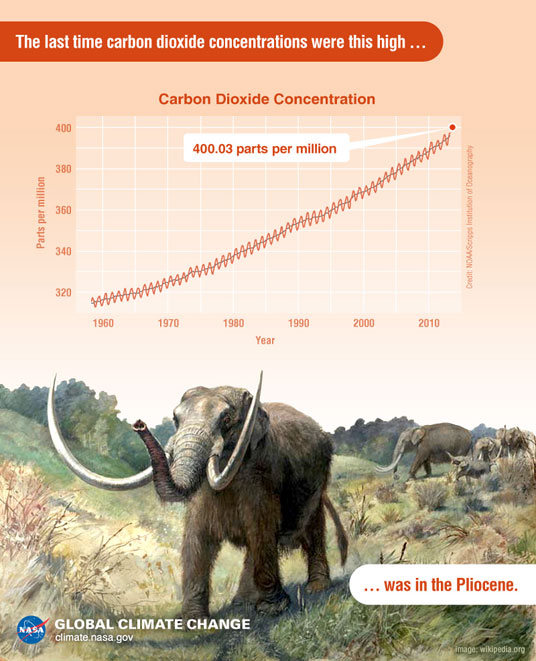Ask NASA Climate | May 16, 2013, 14:45 PDT
Entering unknown territory
Carbon dioxide milestone passed

Imagine there are no people. Imagine a planet where the sea level is about five to 40 meters (16 to 131 feet) higher than normal. Imagine a planet that is hotter and wetter. Imagine, worldwide, it’s roughly 3 to 4 degrees Celsius (5.4 to 7.2 degrees Fahrenheit) warmer than today. And the North and South poles are even warmer still – as much as 10 degrees Celsius (18 degrees Fahrenheit) hotter than today.
Welcome to the Pliocene. That was the Earth about three to five million years ago, very different to the Earth we inhabit now. But in at least one respect it was rather similar. This is the last time that carbon dioxide (CO2) levels were as high as they are today.
On May 9, 2013, CO2 levels in the air reached the level of 400 parts per million (ppm). This is the first time in human history that this milestone has been passed. A preliminary daily average reading of 400.03 ppm was reported by the U.S. National Oceanic and Atmospheric Administration (NOAA), which operates the Mauna Loa Observatory in Hawaii where these measurements are made. While 400 sounds like just another number whose meaning is hard to grasp – similar to, say, world population recently hitting seven billion – these things do resonate, says Dr. Gavin Schimdt of NASA’s Goddard Institute for Space Studies. “People respond to anniversaries – why is 10 years after 9/11 more worthy of note than nine or 11 years? The importance of crossing 400 ppm is simply that it allows us to mark the occasion, and to demonstrate to the future that we knew where we were headed."
CO2 is the most important man-made greenhouse gas, which means (in a simple sense) that it acts like a blanket trapping heat near the surface of the Earth. It comes from the burning of fossil fuels such as coal, oil and natural gas, as well as deforestation. The level of CO2 in the atmosphere has risen from around 317 ppm in 1958 (when Charles David Keeling began making his historical measurements at Mauna Loa) to 400 ppm today. It’s projected to reach 450 ppm by the year 2040.
One of the problems is that CO2 lingers, both in the atmosphere and in the oceans (where it is being absorbed and acidifying the waters, with potentially big impacts on marine life). More than half of the CO2 is removed from the atmosphere within a century, but about 20 percent remains in the air for many thousands of years. Because of slow removal processes, even if we massively reduced our emissions of CO2 right now, atmospheric CO2 would continue to increase in the long-term. The CO2 we emit today, and that we have emitted since the advent of the Industrial Revolution, has long-term consequences that future generations will have to live with.
Some scientists, like NASA’s James Hansen, argue that CO2 must be limited to around 350 ppm in order to prevent “dangerous” climate change. As Hansen wrote in a 2008 paper, “If humanity wishes to preserve a planet similar to that on which civilization developed and to which life on Earth is adapted, paleoclimate evidence and ongoing climate change suggest that CO2 will need to be reduced … to at most 350 ppm.”
To some, crossing the threshold of 400 ppm is a signal that we are now firmly seated in the “Anthropocene,” a human epoch where people are having major and lasting impacts on the planet. Because of the long lifetime of CO2, to others it means we are marching inexorably towards a “point of no return,” into territory that is unknown for the human race.
To hear what NASA scientists are saying about this milestone, click here.
